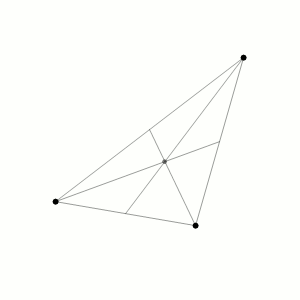User Experiences Amidst Unpredictable Interactions
TL;DR: In the era of generative AI, UX designers must navigate complexity while ensuring user-friendliness. This article explores their role as guides through the chaos of generative responses, drawing inspiration from the enigmatic three-body problem analogy, where interactions can be as complex and unpredictable as celestial bodies.

The digital interface landscape is undergoing a significant transformation, with generative AI interfaces leading the charge. These interfaces, driven by the capabilities of artificial intelligence and machine learning, introduce a complexity that goes beyond traditional UX paradigms. In the world of generative AI, the user experience becomes a dynamic and ever-evolving entity, inviting us to explore uncharted territory where user interactions can be as unpredictable as they are innovative.
The Traditional UX Paradigm: Object, Trigger, Response
In the realm of User Experience (UX) design, digital interactions often follow a well-known path, often referred to as “the golden path.” This journey symbolizes the ideal user flow, a predictable sequence where users encounter ‘objects,’ initiate ‘triggers,’ and receive ‘responses’ that align with their expectations. Think of it as a choreographed dance where user intent seamlessly meets system behavior. However, in the world of generative AI interfaces, while this path remains reliable, it’s no longer the sole destination as the landscape expands into unpredictable realms.
Now, let’s take a deeper dive into the core elements* of UX design — ‘Object,’ ‘Trigger,’ and ‘Response’ — to understand how they shape the traditional user experience and adapt in the context of generative AI interfaces.

Object: The Heart of Interaction
The ‘object’ stands as a fundamental element with which users interact. These elements can take various forms — buttons, text fields, and more — serving as the foundational building blocks of the interface. Users rely on visual cues and affordances to understand how to engage with them. In the physical world, think of a door handle as a real-world ‘object.’ It’s a tangible, everyday element that people interact with regularly.
Trigger: Initiating Action
The ‘trigger’ serves as the catalyst, initiating user actions that prompt specific responses from the interface. In traditional user interfaces, this concept is straightforward, with users triggering predefined actions by interacting with static elements. Imagine the ‘trigger’ as the act of gripping and turning a door handle. This user action sets off a specific response, either opening or keeping the door closed, depending on its state.
Response: Meeting Expectations
The ‘response’ holds the essence of user interaction. It’s where actions culminate in expected outcomes, creating a sense of familiarity and predictability. This predictability ensures a smooth and intuitive user journey along well-trodden paths. For example, the response to turning a door handle relies on the door’s state, whether it’s locked or unlocked. If the door is unlocked, turning the handle typically opens it, granting access to the other side.
A Dynamic Shift: Chaos in Generative AI Interfaces
However, as we delve into the world of generative AI interfaces, a more nuanced understanding of these elements comes into focus. The ‘object,’ often embodied as a dynamic text field or an evolving prompt chip, retains its position as a comprehensible entity, even in this evolving landscape. It adapts to user input and AI-generated content, providing an interactive canvas for users.
Similarly, the ‘trigger’ remains the initiator of user requests, propelling interactions forward and serving as a bridge between intent and execution. Users continue to initiate actions through triggers, preserving the foundational connection between human intention and system functionality.
Where generative AI interfaces distinguish themselves lies in the ‘response.’ Here, the landscape undergoes a dramatic shift.
The ‘response’ transcends predictable patterns, venturing into uncharted territory where it delights, surprises, and, at times, frustrates. It becomes a realm of creative exploration, where AI-generated content can be as unpredictable and unreliable as it is innovative, leading to experiences that ignite curiosity and wonder in users.
This shift challenges us to design interfaces that artfully balance the known and the unknown, delivering delightful user experiences amid the uncertain potential of the generated ‘response.’

The Three-Body Problem
The three-body problem, a renowned issue in physics and celestial mechanics, provides a fitting analogy. It involves the study of the motion of three celestial bodies under the influence of mutual gravitational attraction. Unlike the two-body problem, where motion can be predicted, the three-body problem is infamously intricate. The interactions among all three bodies result in chaotic and unpredictable trajectories, pushing the boundaries of our ability to precisely calculate their positions and movements over time.

This analogy resonates with the world of generative AI, where even minor variations in user input or AI algorithms can lead to significantly different responses, akin to the unpredictable celestial orbits.
For instance, picture a newcomer to generative AI interfaces trying out a writing assistant. They type in what seems like a simple request: ‘Help me write a playful email.’ In conventional systems, one might expect a structured response — perhaps an email template with guidance on striking the right balance of whimsy in the message, akin to measuring the ‘dad-ness’ factor to perfection.
However, in this dynamic generative AI interface, the ‘response’ could transcend predictable patterns, generating creative surprises. In this scenario, the user receives a response that might include a Shakespearean sonnet or a recipe for apple pie, far from the expected playful email template. Frustrated and baffled by the unpredictability, the novice user may become disenchanted with the technology, dismissing it as unreliable and impractical for their needs.
This example underscores the delicate balance we must strike when crafting generative AI interfaces. While unpredictability can spark creativity, it must be harnessed judiciously to avoid overwhelming users and causing them to abandon the technology due to frustration.

Designers as Navigators of Chaos
In this enigmatic realm, UX designers emerge as navigators of chaos. They grapple with the unpredictability that arises from the convergence of artificial intelligence and human experience. While we can discern the first two elements — the ‘object’ and the ‘trigger’ — with relative certainty, the third element — the ‘response’ — remains as elusive as celestial trajectories in the night sky.
Designers bridge the gap between human intention and AI’s creative potential, crafting interfaces that spark curiosity, inspire exploration, and delight users amid uncertainty. They embrace both the known and the unknown, guiding users through a digital cosmos of limitless possibilities.
- Don Norman’s book The Design of Everyday Things describes the core interaction pattern of objects, triggers, and responses in several places. One of the most concise examples is in Chapter 4, “Knowing What to Do: Constraints, Discoverability, and Feedback.”
- Ted Chiang’s article “ChatGPT Is a Blurry JPEG of the Web” is important to read as it highlights the randomness of results and hallucinations that can occur when using large language models.
Navigating chaos: Designing for a three-body problem was originally published in UX Collective on Medium, where people are continuing the conversation by highlighting and responding to this story.

Leave a Reply